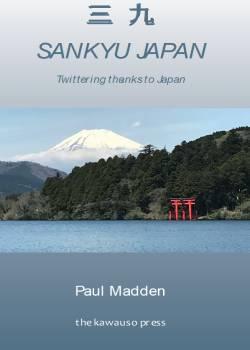Sankyu Japan: Twittering thanks to Japan

By Paul Madden
The Kawauso Press (2022)
ISBN-13: 978-1838372910
Review by Ra Mason
In this highly inventive book, Paul Madden maximises his extensive and varied experiences in Japan to provide a unique and, for many, fascinating series of insights into thirty-nine (san-kyu, or "thank you") aspects of Japanese scenery, history, life and culture. The concept of using tweets made by the author and the responses to them is ingenious. It brings a new edge and technological modernity to the interdisciplinary genres of biographical, historical and travel writings. In so doing, Madden has provided a text that is both a joy to read and a statement work in terms of its innovation and originality.
The book opens with a sensibly scene-setting selection of spectacular Castles (pp. 1-7), the beautiful Inland Sea (pp. 9-14) and enchanting Japanese Gardens (pp. 21-26), bound together with the stickily irresistible staple of rice (pp. 15-19). This combination sets the scene for the following thoughtful, if somewhat higgledy-piggledy, arrangement of thirty-five more tweets and their responses, taking the reader on a scenic and culinarily lavish adventure around all forty-seven of Japan’s prefectures.
Particular highlights include fascinating pieces of interdisciplinary knowledge about Japan that the reader would almost certainly never acquire if it weren’t for their inclusion by the author among both the more famous and less obvious entries that have been picked out. For example, under Lakes, the discussion of Sir Ernest Satow (p. 63) offers a rarely covered insight into how Britain forged early links with Japan’s ruling class, while the entry on Trees not only offers atmospheric recommendations for which fine forests to visit, but also explains why wood is so popular as a construction material in Japan and how fire is a constant threat that has traditionally had to be countered with special measures (p. 107).
At the same time as infusing the text with these items of interest, Madden manages to make them both effortless to absorb and somehow seemingly interwoven through the pages. This is achieved, more than anything, by narrating each entry with personal feelings about the topic and his, and tweet followers’, emotional responses to them. For instance, the pomp and power of the new Emperor’s Enthronement is conveyed with a sense of awe at having witnessed such a truly historic spectacle (p. 218). Similarly, there is an unapologetic but humble recognition of the specific significance to a British diplomat of the Choshu Five and Satsuma Students, for which a tweet is included in the volume to express Madden’s living of a learned history, (pp. 52-53), despite this meaning that the social-media reaction was unsurprisingly reduced as a result.
If there is to be one criticism of the content, it could be that a good number of the entries act as a kind stereo-type reinforcement with a twist of the new for the would-be Japan know-it-all. That is simply to say that readers who have a preconceived idea about what makes Japan unique, mysterious or attractive might use the extra insights provided by Madden’s tweets and the reactions to them as a way to consolidate their own distorted images of the country. The inclusion of so many iconic Japanese items and features, such as Chopsticks (pp. 175-179), Kimono (pp. 185-190), Mt Fuji (pp. 227-233), Sake (pp. 137-142) and Sushi (pp. 87-92), for example, magnifies this effect. Hence, for the skim-reader, Madden’s amazing journey could be reduced to a kind of articulate “Duffer’s Guide” to Japan.
Nevertheless, the author can hardly be blamed for this or his honest choices on what enthralled him about the country. And the combination of famous points of interest interspersed with the rarer and more personal, including not only the Choshu Five and Satsuma Students (pp. 47-53), but also Meiji Mura (pp. 181-184), Shinjuku Seibo Byoin Hospital (pp. 153-158), The British Embassy (pp. 221-225) and Walls (pp. 81-86), illustrates the depth of knowledge and extent of thought being expressed in one such compact piece of writing. Indeed, the clarity and detail with which all the experiences attached to each of the tweets are recounted and conveyed is startlingly impressive; even more so considering the more than thirty-year time-period that they span.
In that regard, the detailed explanation of what lies behind each tweet serves to both enthral and inform the reader. As a combination, the tweets thereby quite literally act as a moving autobiography, academic documentary history and enticing visitor’s guide rolled into one! Personal anecdotes offer humour and colour, while the depth and breadth of content mean that the soon-to-be visitor to Japan will need little more than the most basic of mobile phone technology (and perhaps a few extra hard-earned savings) to enjoy an unrivalled travel experience with this single volume in hand.
After complete reading, the book leaves one with a sense of having completed one’s own rambling journey through Japan with the author – experiencing the (mostly) ups and (few) downs of Madden’s undulating timespan in-country. In this regard, the author has masterfully put together a means by which to provide a concise and engaging introduction to Japan. He also does so without removing the down-to-earth style that undoubtedly makes his writing more attractive than the often over-hyped or pretentious-sounding prose churned out by travel guides or other commercial literature. And in terms of stylistic innovation, too, the tweeting aspect and shorter chapters create excellent accessibility for the reader, which will surely serve to capture a wide audience. As such, I have no doubt that most of Madden’s readers, or dare I say followers, will gratefully offer their thanks by way of a heartfelt sankyu!
* Sankyu Japan by Paul Madden is available on Amazon in ebook form and hard copies can be ordered from TheKawausoPress@gmail.com.

